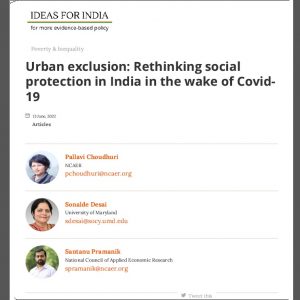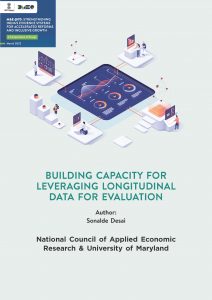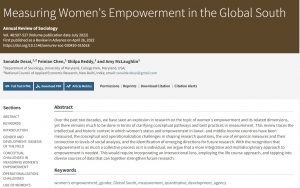
Economic insecurity caused by lockdowns during the early days of Covid-19 forced many households to rely on government welfare schemes to fulfil their consumption needs. Using data from the June 2020 round of the Delhi NCR Coronavirus Telephone Survey, this article shows that few households received both foodgrains and cash transfers, particularly in urban areas, and urban residents were also eight percentage points less likely to receive cash transfers vis-à-vis their rural counterparts.

The right to obtain a legal abortion is vital to reduce inequalities.

Professor Sonalde Desai wrote a book chapter on “Building Capacity for Leveraging Longitudinal Data for Evaluation”, M&E @70: Strengthening India’s Evidence Systems for Accelerated Reforms and Inclusive Growth, A Compendium of Essays. The Compendium of Essays was released on March 16, 2022 at DMEO’s Second National Conference on Monitoring, Evaluation and Learning by Hon’ble Vice Chairman, NITI Aayog.
The compendium is available on the DMEO website:

Over the past two decades, we have seen an explosion in research on the topic of women’s empowerment and its related dimensions, yet there remains much to be done in terms of clarifying conceptual pathways and best practices in measurement. This review traces the intellectual and historic context in which women’s status and empowerment in lower- and middle income countries have been measured, the conceptual and operationalization challenges in shaping research questions, the use of empirical measures and their connection to levels of social analysis, and the identification of emerging directions for future research. With the recognition that empowerment is as much a collective process as it is individual, we argue that a more integrative and multidisciplinary approach to empowerment is needed. This would require incorporating an intersectional lens, employing the life course approach, and tapping into diverse sources of data that can together strengthen future research.

This article examines the difference between the estimates of unemployment rate and worker population ratio in urban areas in the Periodic Labour Force Surveys for the quarters ending March and June 2021. It further investigates the sample size needed if the survey is to be equipped to detect the quarterly changes of specified magnitudes in the respective population parameter.










